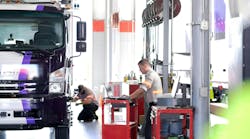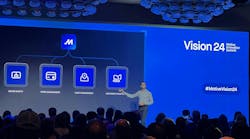Crossing borders has been a hassle since time immemorial. In the really good old days, great walls were built to make borders impermeable. More recently machine guns and barbed wire have done nicely for sealing borders.
Here at home, of course, shippers of legitimate goods crossing Uncle Sam's border have only had to fear red tape. It won't kill you, but getting through it does make for long days and lots of expense for carriers and their customers.
That's why the entire international trade community in this country is thrilled, to put it mildly, about the prospect of the U.S. Customs Service (Customs) implementing what it calls the “Automated Commercial Environment (ACE).”
This new computer platform will support various import- and export-tracking functions for the government. Once ACE is implemented, clearing commercial shipments through Customs promises to become a virtual cake walk.
A pilot version of ACE, called the National Customs Automation Prototype, has been tested at the border crossings at Laredo, Tex., and at Detroit and Port Huron, Mich.
According to Customs, ACE will truly be up to the speed of business as we now know it — meaning it will be fully compatible with Windows and accessible via the Internet.
It will supplant the service's 18-year-old Automated Commercial System (ACS), a COBOL-based import-filing system. ACS suffers frequent “brownouts” (slowdowns) because its ’80s-vintage technology is swamped by the demands of today's global marketplace.
Rather than being built on a mainframe computer like ACS is, ACE will enjoy a modular structure that will make overhauling and modernizing it much easier.
In addition, ACE will allow customs transactions using the International Trade Data System (ITDS), a new data-collection setup that will feed into various federal agencies and is designed to eliminate redundant paperwork requirements. An ITDS pilot is set to launch this summer at two border points near Buffalo, N.Y.
And thanks to ITDS, carriers will be able to file electronic manifests for the first time. That means trucks will cross the border faster — because the information needed for their cargoes to clear customs will arrive electronically before they do.
The big question is not so much what ACE will do, but when it will do it. Customs projects its first phase will be up and running in 2003. But the exact timetable will depend on how well future funding requests are received by Congress.
It's estimated that ACE will cost $1.3-billion to set up and implement, and another $160 million a year to operate and maintain. Even assuming it will be fully funded by Congress, it won't be completely up and running for at least another four years. However, the first phase of the project could be in use within two years.
OFF THE GROUND
In December, Congress earmarked an initial appropriation of $130 million, or 10% of the total project cost, to at least get ACE off the ground. The next significant move should take place this month, when Customs is expected to name a primary contractor for actually building ACE.
According to Customs, ACE's “cutting-edge technology” will increase functionality, streamline processes and generate billions of dollars in government and trade benefits. “An ACE cost-benefit analysis,” says the service, “identified a life-cycle benefit of $3.3 billion, for a 13.7% return on investment.”
The benefits ACE will give those engaged in trade, Customs promises, will be “nationally managed import activities, reduced reporting burden and a reduction in operational costs.”
By the way, the service doesn't plan to just jump from one system to another. Rather, ACS and ACE will operate side by side temporarily. In the first stage of ACE implementation, according to Customs, a “transparent common interface will be completed that will minimize the need for dual operations.”
ACE, then, amounts to a very exciting development that will be closely watched — and lobbied for — over the next few years. But there is more good news, and it's of the here-and-now variety.
Some other technological innovations introduced by Customs and by the Canada Customs & Revenue Agency (CCRA, see box) are already bearing fruit at various points of entry.
BUSY CARRIERS
Two of the nation's big LTL carriers, Consolidated Freightways (CF) and Roadway Express, are enthusiastic supporters of ACE. Both also have extensive experience using other recently added programs to help speed customs clearance for their customers' freight.
Roadway, in fact, last year received one of then-Vice President Al Gore's “Hammer Awards” (which honored public/private sector success stories). The carrier was cited for its innovative work with government agencies and the Assn. of Laredo Forwarding Agents to improve the effectiveness of Customs' Automated Export Service (AES). Roadway was the first carrier to participate in the ACE pilot program conducted at Laredo, Tex.
AES, which tracks shipments crossing the Mexican border, creates a standard electronic format for exchanging transportation and commodity information.
According to Bob Carr, Roadway's vp-international, AES cuts down on data-entry errors and paperwork, eliminating the Shipper Export Declaration (SED) altogether, and helps the carrier keep customers informed about freight crossing the border via EDI.
“AES has helped us provide better customer service,” says Carr, “because we can now provide real-time status of their shipments while crossing the border, as well as delivery time and billing information.”
Moving north, earlier this year Roadway began expanding its participation in Customs' Pre-Arrival Processing System (PAPS), which now extends to all major crossings along the U.S.-Canada border.
Roadway and its Canadian subsidiary, Remer Express Lines, have worked with Customs over the past few years on the development of PAPS and were among the first carriers to take part in the pilot project.
By capitalizing on PAPS, Roadway's specially trained “Border Ambassadors” were able to quickly forward export documents to brokers for presentation to Customs-even as the actual shipments are rolling toward the border.
STREAMLINING IN-BOND
Also busy on the border is Consolidated Freightways, which last fall became the first LTL carrier to activate a direct electronic link between Customs and the company's border terminal in Toronto to streamline in-bond freight movements.
Shipments entering the U.S. are placed in-bond when part of the required documents for entry and clearance are unavailable, or when freight is moving directly from point of importation to another point of exportation.
When a shipment is in-bond, a carrier or broker assumes responsibility for fulfilling customs requirements before freight is released to the consignee. The in-bond process requires passing along clerical data before the freight can move.
Typically, shippers hire a broker to prepare and manage the in-bond documents processed at the border. The new electronic system eliminates the need for these broker services and thereby speeds up the whole in-bond process.
CF uses software written for Customs' “QP” application to gain direct access to the Automated Broker Interface (ABI) network system for electronic transfer of in-bond documents.
“The technology made available by Customs is helping automate our in-bond clearance process,” says Dennis Freeman, CF's customs compliance manager. “The link gives CF the benefit of being a one-stop shopping tool for shippers moving freight across the U.S. border.
“When our terminal receives in-bond cargo,” he continues, “we electronically transmit required documentation directly to Customs in real time. Under this new system, paperwork is eliminated and CF drivers no longer stop at a brokerage at the border.
“By contrast,” Freeman adds, “the traditional system is paper-ridden, labor-intensive and involves time-consuming steps for brokers and carriers as well as Customs officials. We've moved this process into an electronic environment, which changes how we can do business at the border.”
Freeman points out that any carrier can do what CF is doing with in-bond documentation by acquiring the necessary software. “We bought the necessary software to interface with Customs and integrated it with our mainframe system so we can activate the in-bond process from anywhere in our network,” he advises.
According to Freeman, CF is now updating the system to provide shipment-release information to all the company's terminals, and its customers, so inquiries can be made in real time on the status of in-bond shipments.
The upshot of in-bond automation is that many CF customers receive their freight one to two days sooner. Freeman regards it as a value-added tool, since CF does not charge customers for its benefits.
BAR CODE
This month Roadway will begin testing a new two-dimensional bar code system for inbound documents as part of Customs' automated QP/WP processes for in-bond shipments.
“The test phase will be conducted at the Port Huron, Mich., crossing,” reports Beverly Brookman, international administrative manager for Roadway. “The bar code is supposed to take all the data from the paper form so a Customs official will only have to pass a reader over it to capture the information, with no need for data entries. This will translate into a major time savings.”
And Brookman says Roadway is looking forward to the start of testing for the government's aforementioned ITDS at Niagara Falls and possibly at Laredo. “ITDS,” she points out, “is more advanced than the PAPS system and will further streamline customs processing of in-bond and all other types of shipments.
“Right now,” Brookman continues, “we're required to list all incoming shipments on an inward cargo manifest and have customer documents to back those up.
“But with ITDS in place,” she explains, “we'll be able to send the same information electronically-even before the shipment reaches the border. It will electronically concentrate our shipments to allow what will amount to an almost ‘pre-clearance’ of our trucks. Once the truck arrives at the border, the shipment on it will just have to be verified. ITDS will also help brokers and Customs by allowing them to better manage their work flow.”
O CANADA
Brookman also advises that U.S. Customs is not alone — or necessarily the front-runner — in automating the border. She tips her hat to Canada for being “the leader among NAFTA nations for customs automation by looking closely at everyone's needs involved.
“Canada's CCRA,” Brookman continues, “constantly fine-tunes their systems to make them more efficient. This fall, the agency is expected to roll out its Customs Self-Assessment (CSA) program, which we expect will take automation a step further.”
CSA will plug in data from importers, as well as carriers and brokers, and allow shippers to make one periodic duty payment to the Canadian government — and thus require no preshipment transactions.
“It's an exciting new movement for crossing international borders,” says Brookman. “Right now, Roadway is working to change its computer systems to accommodate CSA once it's available.”
Know your ABCs
Just because you've cut through the red tape doesn't mean you won't drown in the alphabet soup. If there's anything governments like as much as rules and regulations, it's initials and acronyms to describe them. Here briefly annotated are the ones that were most frequently encountered in researching the U.S. side of this story:
-
ABI: Automated Broker Interface. A network system for the electronic transfer of in-bond shipment documents.
-
ACE: Automated Commercial Environment. The much anticipated platform under development to support various crucial import- and export-tracking functions.
-
ACS: Automated Commercial System. The woefully outmoded import-filing system due to be replaced eventually by ACE.
-
AES: Automated Export System. Used for shipments crossing the Mexico-U.S. border, it provides a standard electronic format for exchanging information.
-
ITDS: International Trade Data System. A data collection system under development that will pipe information required of shippers to various federal agencies. More advanced than existing PAPS.
-
PAPS: Pre-Arrival Processing System. In use at all major U.S.-Canada crossings, it allows quick forwarding of export documents to brokers.
-
SED: Shipper Export Declaration. Paperwork that's eliminated by the use of AES .


